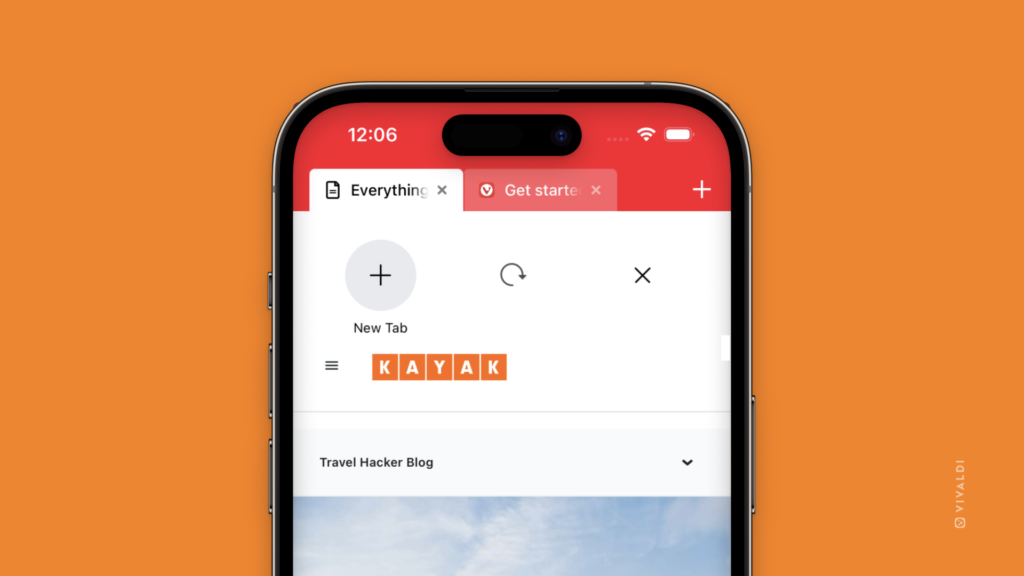Vivaldi Tips
A huge collection of Vivaldi browser tips, tricks and hacks.
Tip #407
janvier 17, 2024
Add images to your Vivaldi.net blog posts with drag and drop.
Illustrations can add a lot to your blog content. When adding a new image to your post, you can always look for it through the File Manager/Finder dialog, but if you have the folder with images already open on the side, you can also just drag the image to your blog post.
To add images using drag and drop:
- In the post editor, add an Image or Gallery block.
- Place the browser and image folder windows side by side.
- Drag the file to the image block.
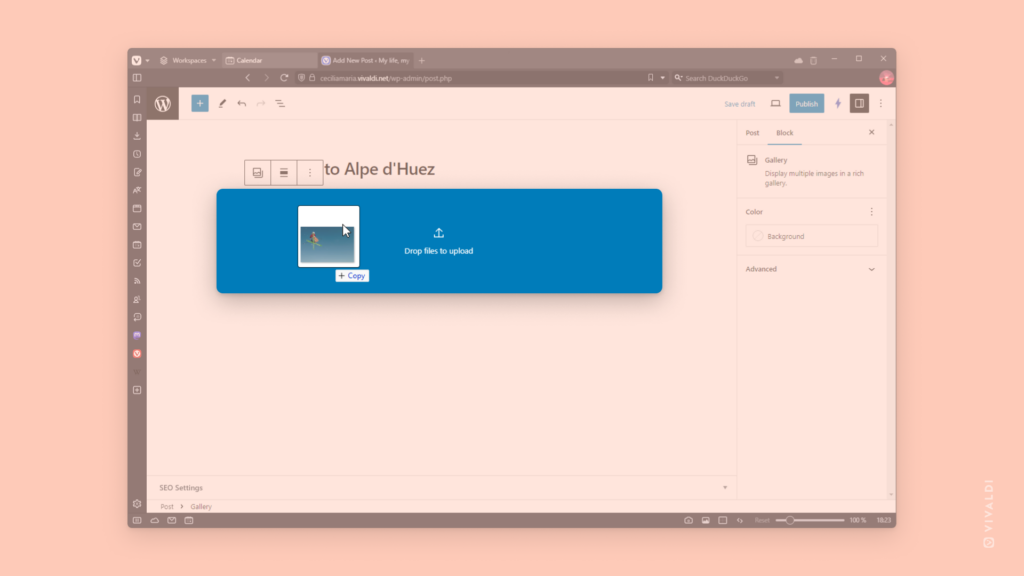
Tip #406
janvier 16, 2024
Divide events and tasks in your Vivaldi Calendar by category into separate calendars.
A calendar is vital for keeping up with a busy schedule. To make it easier to view and manage your events and tasks, you can create multiple calendars for various types of obligations in your Vivaldi Calendar. You can also assign a different color for each calendar to make the events stand out more.
To create a new calendar:
- Go to Settings > Calendar > Calendars.
- Click on + Add Calendar below the list of existing calendars.
- Select which account the calendar should belong to, give the calendar a name, choose a color and look over
- Click « Save » to create the new calendar.
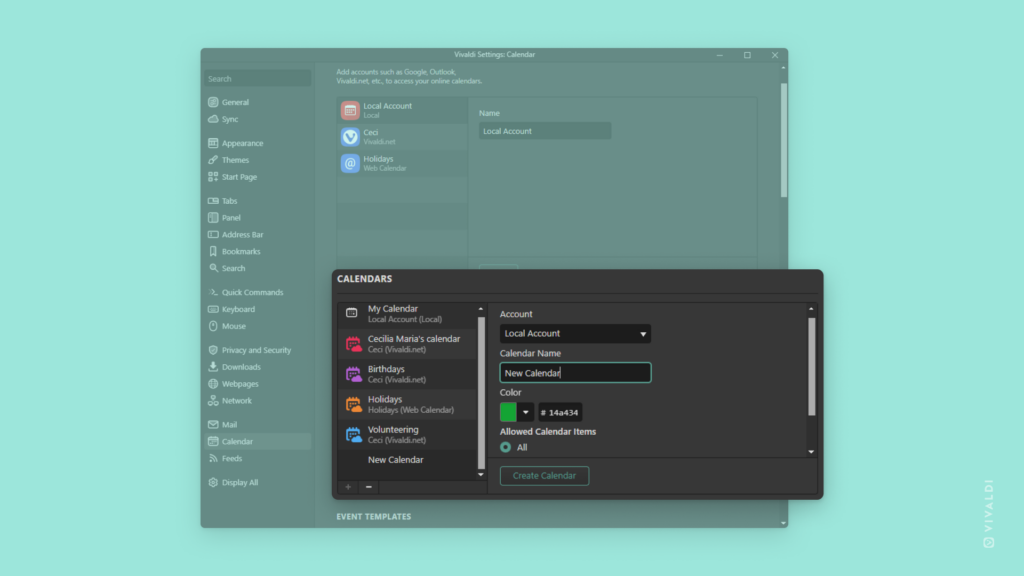
Tip #405
janvier 15, 2024
Set different default Search Engines for Standard and Private Tabs in Vivaldi on Android.
You may be comfortable with one search engine for your everyday browsing but prefer a different search engine when you want stronger privacy. In Vivaldi on Android, like in Vivaldi on desktop and iOS (see Tip #378), you have the choice to set separate Search Engines as the default ones for Standard Tabs and Private Tabs.
To update the default search engines:
- Go to the Vivaldi menu > Settings > Search Engine.
- Select either “Standard Tab” or “Private Tab”.
- Tap on the search provider you want to set as the default one.
- Exit by going back to the main Settings menu using the
 back arrow.
back arrow.
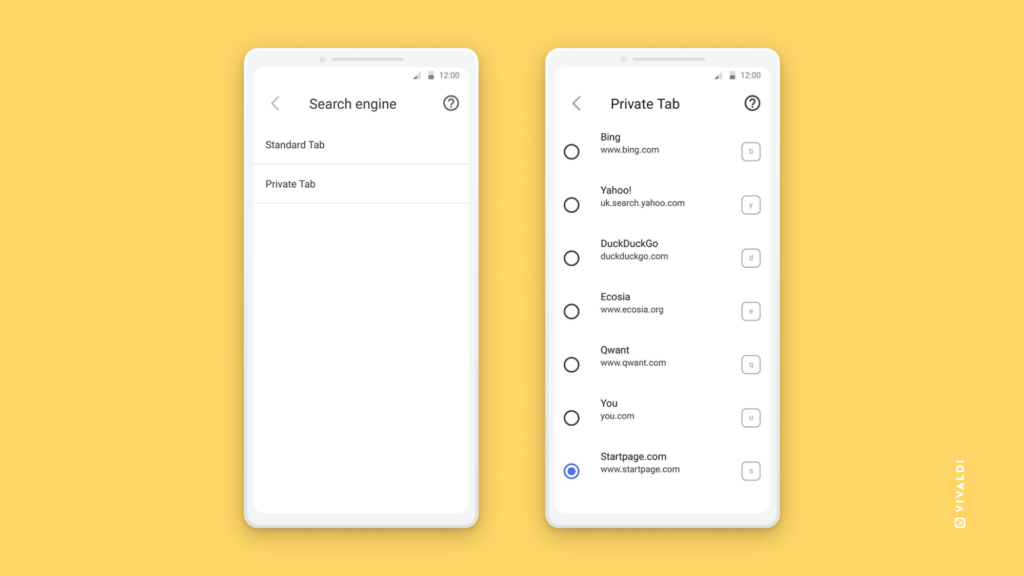
Tip #404
janvier 12, 2024
Make your Notes more readable with Markdown formatting.
Markdown is a simple markup language used to create rich text (e.g. HTML) with a plain text editor. It lets you add basic formatting to your text, using symbols known and accessible on all keyboards.
To use Markdown in Vivaldi Notes:
- Open the Notes Panel or Notes Manager and select or create a note.
- Make sure the Editor/Text view is enabled.
- Use the basic Markdown syntax to add headings, lists, bold text, etc.
- Switch to Markdown/Visual view to see the outcome.
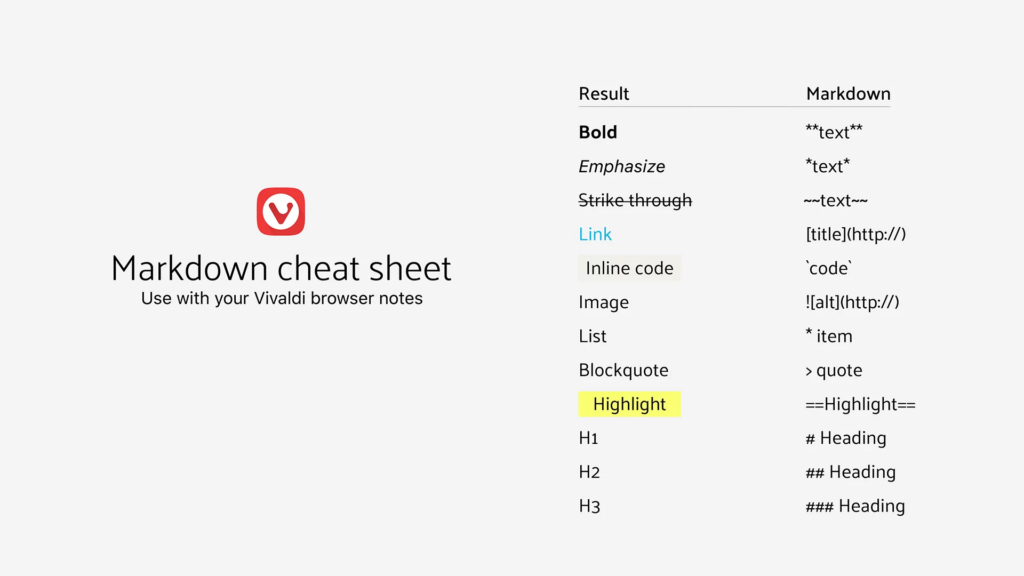
Tip #403
janvier 11, 2024
Jump back in time by enabling Automatic Session Backups.
With Saved Sessions you can look up a single tab or restore your complete browsing session from a specific time in the past. You can save Sessions manually or have them be saved automatically once every hour.
To automatically back up all your open tabs as a Saved Session:
- Open the Sessions Panel.
- At the bottom of the panel, click on « Automatic Session Backup ».
- Select how many days worth of backups you want to keep:
- Last day,
- Last 3 days,
- Last 5 days,
- Last 30 days.
- Click « Save ».
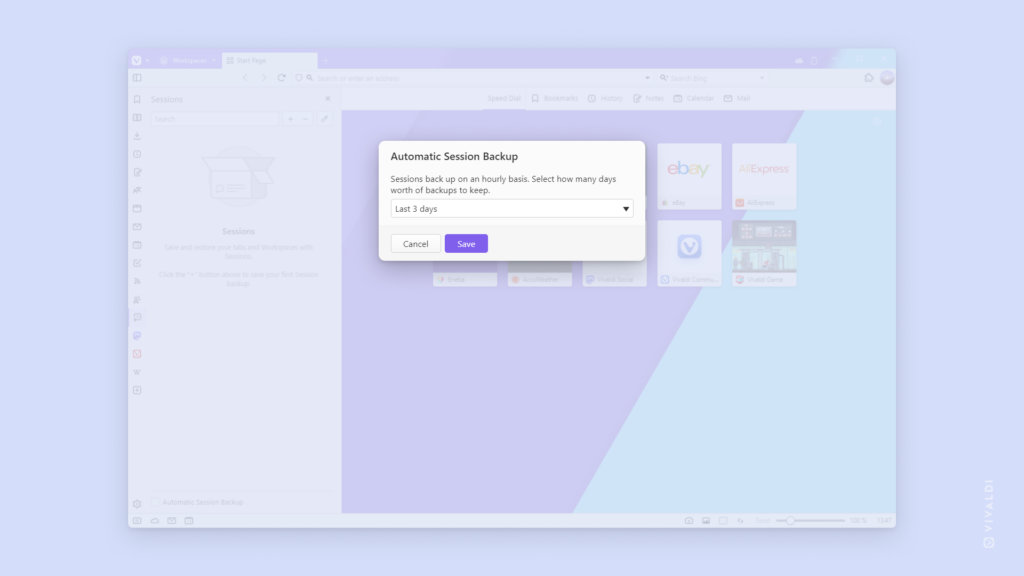
Tip #402
janvier 10, 2024
Keep the most important tabs in Vivaldi on iOS within easy reach by pinning them.
Tabs can accumulate fast on mobile devices, to make sure you can always access your frequently used tabs quickly, you can pin them in place. In the Tab Switcher, Pinned Tabs will appear at the bottom, and on the Tab Bar, they’ll always be the first tabs on the left.
To pin a tab:
- Open the Tab Switcher.
- Long-press on the tab’s thumbnail.
- Select « Pin Tab ».

Tip #401
janvier 9, 2024
Re-draft a post on Vivaldi Social if you didn’t get it exactly right the first time.
Did you find a mistake in your Vivaldi Social post after publishing it? If it has already collected likes, boosts, and comments, it’s best to simply edit the post. But if you caught the error immediately after publishing, you can also delete and re-draft the post. That way you can take your time and the post will look fresh and clean after you publish it again.
To redo a post on Vivaldi Social:
- Click on the
 « More » menu button below the post.
« More » menu button below the post. - Select « Delete and re-draft ».
- The post will be moved back to the editor, where you can make the necessary edits.
- When ready, click « Publish » again.
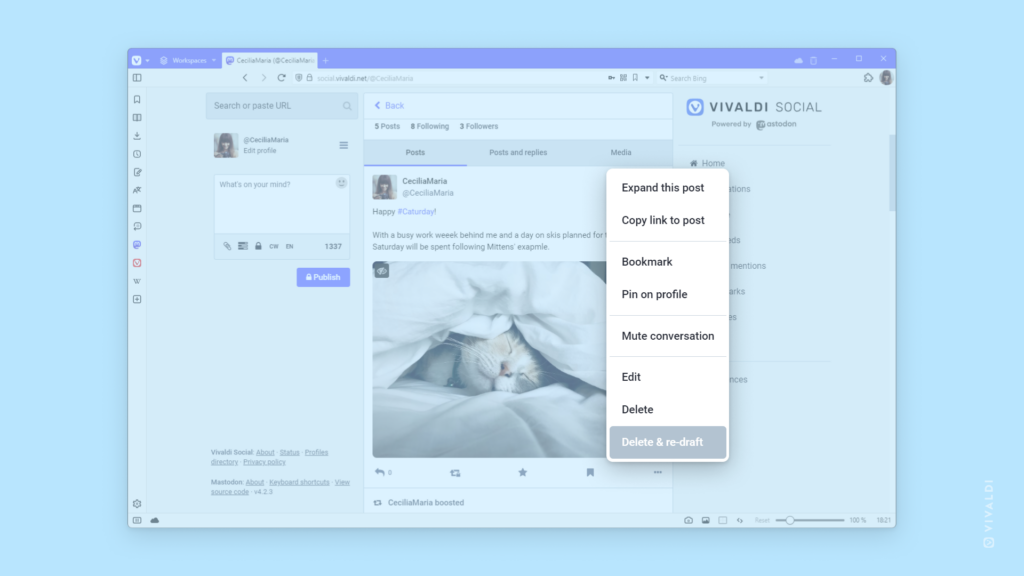
Tip #400
janvier 8, 2024
Move tabs automatically to the correct Workspace with Workspaces Rules.
Workspaces are a way to organize your tabs where you can keep different tabs in different Workspaces, based on a topic or category. You might, for example, have a workspace for work, another for sports, and a third for travel.
To set up Workspace Rules:
- Go to Settings > Tabs > Workspaces.
- Click on Add New Workspace Rule.
- Set up the rule criteria.
- Select which workspace the tab should be moved to.
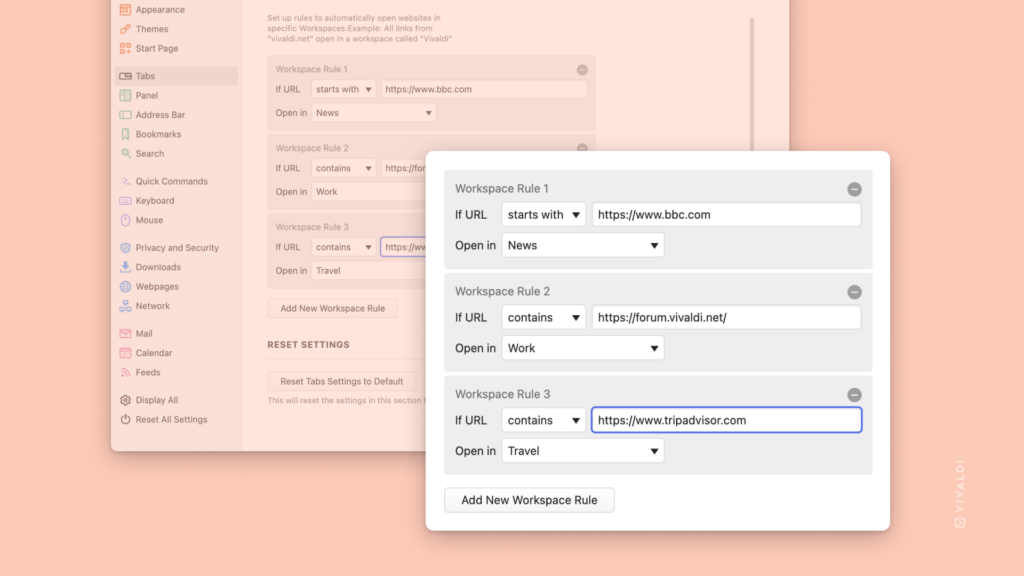
Tip #399
décembre 1, 2023
During this Holiday season follow our Advent Calendar for 24 of our best tips.
End of the year’s festivities are picking up speed. During the month of December, we’re sharing 24 of our best tips from nearly 400 tips about the Vivaldi browser and services with a seasonal twist – 1 on each day until Christmas.
Check out the 1st tip on the link below. 👇
We’ll be back with brand new tips again in January. ✨ Happy Holidays! ✨
Tip #398
novembre 30, 2023
Open Tabs from the Window Panel with a single click instead of a double click.
By default, to switch tabs using the Window Panel, you need to double click on an entry to activate it. If you’d like to switch tabs with only one click, like on the Tab Bar, you’ll need to enable a setting for it.
To enable single click tab switching in the Window Panel:
- Go to Settings > Panels > Window Panel.
- Enable « Activate with Single Click.
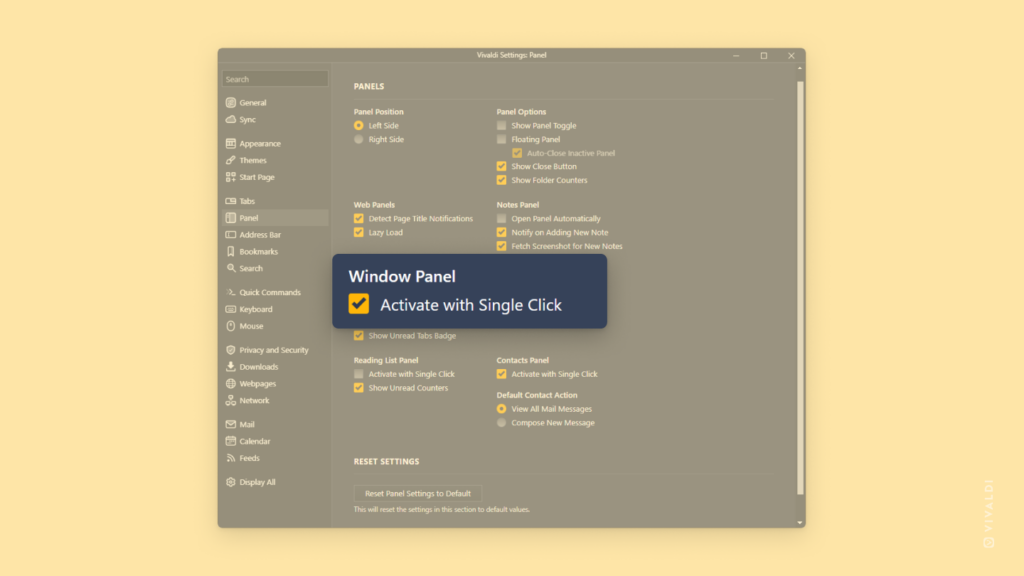
Tip #397
novembre 29, 2023
Pause incoming messages in Vivaldi Mail by taking the account offline.
If you temporarily want to stop receiving messages for a mail account, but don’t want to remove the account from Vivaldi Mail altogether, you can enable offline mode.
To take a mail account offline:
- Go to Settings > Mail > Mail accounts.
- Select the account.
- In Identity settings, enable « Take Account Offline ».
You’ll still be able to send messages from the account, but won’t receive any new incoming messages until you turn off the setting.
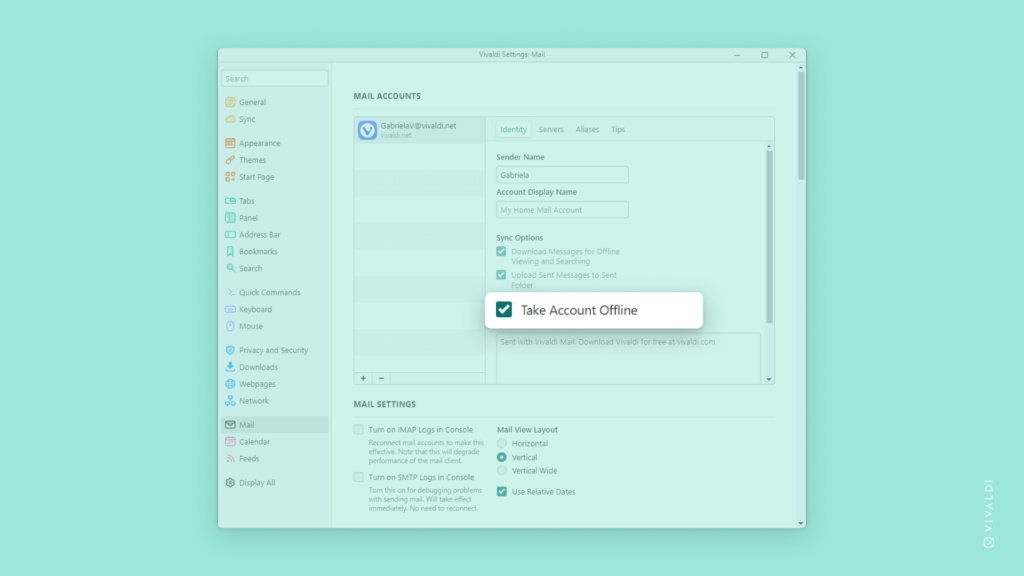
Tip #396
novembre 28, 2023
In Vivaldi on iOS, swipe down from the top of the web page to reload or close the tab, or to open a new tab.
You can find the options to open a new tab and reload the active tab from the main menu of Vivaldi on iOS, and you can close tabs from the Tab Bar or the Tab Switcher, but when you’re at the top of the page, you can also use swipe gestures to do the same.
To reload the tab:
- Start swiping down from the top of the open web page.
- Release your finger to reload the tab.
To open a new tab:
- First, swipe down and then, without lifting the finger, swipe a little to the left.
- When the New Tab option is highlighted, release your finger.
To close the tab:
- First, swipe down and then, without lifting the finger, swipe a little to the right.
- When the Close Tab option is highlighted, release your finger.
